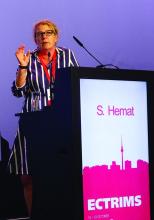Relapse rates coming off fingolimod before or during pregnancy
In another study, which used German registry data on 129 pregnancies that occurred around or after the time of fingolimod withdrawal, up to 56% of women who stopped fingolimod before pregnancy experienced a relapse during pregnancy versus 29% of those who stopped fingolimod upon a positive pregnancy test.
In a comparison of women who stopped fingolimod 1 year to 61 days before their last menstrual period against those who stopped less than 60 days prior to or after their last menstrual period, relapse rates were higher during the first (25.8% for early withdrawal vs. 12.5% with late withdrawal) and second trimesters (32.3% vs. 11.5%) than in the third (9.7% vs. 10.4%), Spalmai Hemat, MD, of the department of neurology at St. Josef Hospital, Ruhr University of Bochum (Germany) reported at the congress.
Relapse rates at 6 months postpartum proved to be similar at 36.7% for women who stopped fingolimod before their pregnancy and 38% in those who stopped later. Difference in the percentage of women experiencing disability progression during pregnancy did not prove to be statistically significant for stopping fingolimod before pregnancy (22.7%) vs. stopping later (11.1%; P = .283), while the 23.8% rate of disability progression after pregnancy among women who stopped the drug later versus 13.6% seen with stopping before was also not statistically significant (P = .31). Relapse during pregnancy was the only significant predictor for relapses postpartum.
“The large majority of women did not experience permanent disability,” Dr. Hemat said, but noted that as many as 10%-20% could experience substantial EDSS worsening (2 or more points) at 6 months postpartum.
Dr. Hemat concluded that more data were needed to see if reintroduction of fingolimod very soon after birth, such as within the first 2 weeks, could reduce the postpartum relapse risk.
Dr. Hemat and Dr. Cerda had no relevant disclosures.
SOURCES: Cerda N et al. Mult Scler. 2018;24(S2):73-4, Abstract 206; Hemat S et al. Mult Scler. 2018;24(S2):74-5, Abstract 207.


